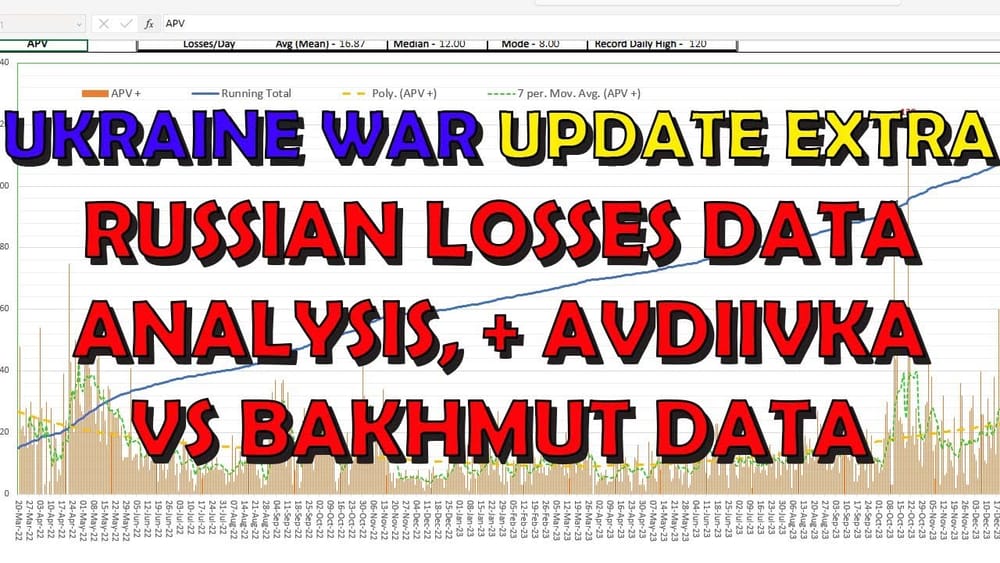Ukraine War Upd. EXTRA: Russian Losses Data Analysis, + Bakhmut vs Avdiivka
Table of Contents 📖
"They're not going to have 93 [drones] a day to get 100 of these larger drones to fire a day. But they use them at the rate they are procuring them."
Hello Team
🎦 00:00-00:11⏩
Jonathan welcomes viewers to an extra nuggets and tidbits video looking at analysis of the war in Ukraine and the daily data provided by Del (link in the video description). Today's video compares Russian losses in Bakhmut with those in Avdiivka. Jonathan has spoken to Del to make sure he understands the data.
Return to top⤴️
Overview of Del's Data
🎦 00:11-02:34⏩
This data looks at personnel losses (which only ever increase - they never go down) and the steeper the blue line, the higher the losses. Whilst this data is based on the Ukrainian General Staff figures, which could include propaganda, inaccuracies, etc., Jonathan has previously explained why he believes this data to be fairly accurate. Jonathan's biggest concern is how many of the personnel figures include the severely wounded. He explains that at the beginning of the war, there were very few pitched battles but this changed as battles such as Bakhmut and the counteroffensives in Kharkiv and Kherson took place.
Return to top⤴️
Analysis of Russian Tank Losses
🎦 03:51-05:51⏩
The data shows that large numbers of Russian tanks were lost at the beginning of the war - this is because they were easy targets for the Ukrainians whilst stuck in columns. More tanks were destroyed during the counteroffensives. Interestingly, very few tanks were used in Bakhmut, with Wagner preferring to use meat assaults to do their work. Tank losses started to rise when the Ukrainians started hitting the advancing Russian forces with artillery, FPV drones and so on. However, the Ukrainians soon realized that this approach was not sustainable so they paused the counteroffensive and resorted to attriting the Russian forces from a distance. The Russians suffered further huge tank losses (55 in one day, 44 in another) in their attacks on Avdiivka. This is because, instead of attriting the Russian tanks, the Ukrainians forced the Russians to attrit their own equipment through their attacks, by using artillery and FPV drones to take out entire columns.
Return to top⤴️
Analysis of Russian Armoured Personnel Vehicle Losses
🎦 06:27-07:05⏩
The data for Russian Armoured Personnel Vehicle (APV) losses (including Infantry Fighting Vehicles, MRAPS and APCs) shows similar trends to those seen with tank losses. Again, there were huge losses at the beginning of the war, during the counteroffensives, as well as at Avdiivka (120 losses in one day, 91 in another).
Return to top⤴️
Analysis of Russian Artillery Losses
🎦 07:05-09:43⏩
Jonathan explains that the data for Russian artillery losses paint a slightly different picture. As with the tanks and APVs, the Russians lost a lot at the beginning of the war. There were also huge losses during the counteroffensives. At this point, the Ukrainians appeared to make a decision to focus on attriting Russian artillery, realizing that they could not continue their attacks without doing so. As a result, the Russians sustained consistent losses. Jonathan believes that the Russians have been less able to replace artillery pieces lost recently, with some days seeing over 60 artillery pieces destroyed.
Return to top⤴️
Analysis of Russian MLRS, Air Defence Systems, Aircraft and Helicopter Losses
🎦 09:44-13:44⏩
Jonathan explains that there is not enough data to glean much information from the Multiple Launch Rocket System figures other than that they are fairly consistent. The same is true for Anti-aircraft warfare systems although the data suggests that the Ukrainians have consistently focused on taking these out since May, realizing this would be necessary for the counteroffensive and the use of F16s, etc. There is not enough data to say much about Russian aircraft losses either, other than that the Ukrainians struggled to take out many aircraft. Jonathan suspects this is why they were so keen to acquire ATACMS. However, we have seen some upticks in Russian aircraft losses more recently which could be down to the arrival of Patriot systems. There is not enough data to tell us very much about helicopter losses either, although Jonathan questions why the data does not include the eight helicopters destroyed in the Storm Shadow strikes on Luhansk and Berdyansk airfields. This could be because it is difficult to verify. It appears that helicopter losses have fallen in recent months which may indicate that the Russians are more cautious about deploying them, for fear of them being destroyed.
Return to top⤴️
Analysis of Russian Cruise Missile and Drone Losses
🎦 13:44-16:25⏩
Looking at the data for cruise missiles, Jonathan observes that there is a consistency in how these were used up to March 2023. He suggests that a gap in the data suggests that the Russians had procurement issues, before they were used more in May and June. A large gap in the data suggests they were stockpiling and did not have the production capability they wanted. It is more likely that they are firing cruise missiles at the rate they are being produced and that this is not a capability they can easily increase. This is supported by the fact that they are now being used at a consistent rate of around 25 a week. The data for drone losses shows a similar story. Jonathan reasons that if they could use more than they are doing, they would be doing so and concludes that production is the limiting factor here.
Return to top⤴️
Analysis of Russian Warship, Vehicle, Fuel Tank and Special Equipment Losses
🎦 16:25-19:54⏩
Jonathan explains that there is not much we can learn from the data for warship losses other than maritime drones have had a significant impact from August 2023 onwards. The data for Russian vehicle and fuel tank losses shows they lost a lot at the beginning, during the counteroffensives and that they have sustained heavy losses since September 2023 when Ukraine changed tactics. The data for special equipment losses tells us that losses have increased since March 2023. Jonathan concludes that, up to this point, the Russians were not using excavators to dig trenches, and were also not using this equipment for surveillance, communications, electronic warfare, etc.
Return to top⤴️
Comparison of Russian Personnel Losses: Bakhmut vs Avdiivka
🎦 19:54-26:41⏩
Jonathan now moves on to compare Russian personnel losses at Bakhmut and Avdiivka. Del has calculated that Russian personnel losses from 5 October 2022 onwards (when the Avdiivka offensive is deemed to have begun) averaged 893 per day, compared to 476 per day before this date. This equates to an extra 417 Russian personnel lost per day, during the Avdiivka offensive, although there will have been other battles taking place. This figure is in line with other estimates. Del has calculated that the total number of Russian personnel lost in Avdiivka (the extra losses above the average) to be 56,723. Based on the area of Avdiivka, this equates to 660 Russian personnel lost per square kilometre. For Bakhmut, Del has taken the 172 days of the battle and compared the losses to the period before the battle commenced (he does not take into account the period after Bakhmut, so this does not include losses from Avdiivka, making this a fairer comparison). He calculates that 59,715 Russian personnel were lost. This is over a longer time period than Avdiivka. Based on the area of Bakhmut, he calculates that 1,435 Russian personnel were lost per square kilometre, making it far more costly in terms of personnel.
Return to top⤴️
Comparison of Russian Equipment Losses: Bakhmut vs Avdiivka
🎦 26:41-29:52⏩
Jonathan explains that when it comes to comparing tank, APV and artillery losses between Bakhmut and Avdiivka, the picture is very different. Bakhmut saw far fewer tank and APV losses, confirming that very little, if any, mechanized equipment was used in the battle. This supports the theory that Wagner favoured meat assaults. Whilst artillery losses were higher in Bakhmut, Jonathan suspects these are likely to be spread throughout the Donbas and not solely related to the Bakhmut fighting. He explains that Avdiivka has been more costly in terms of equipment losses. However, when compared to the huge losses seen at the beginning of the war and during the counteroffensives, the losses during the Avdiivka period are actually about average.
Return to top⤴️
Wrap up
🎦 29:52-30:03⏩
Jonathan thanks Del for providing this useful data analysis and encourages viewers to check out the data for themselves using the link in the video description.
Return to top⤴️



